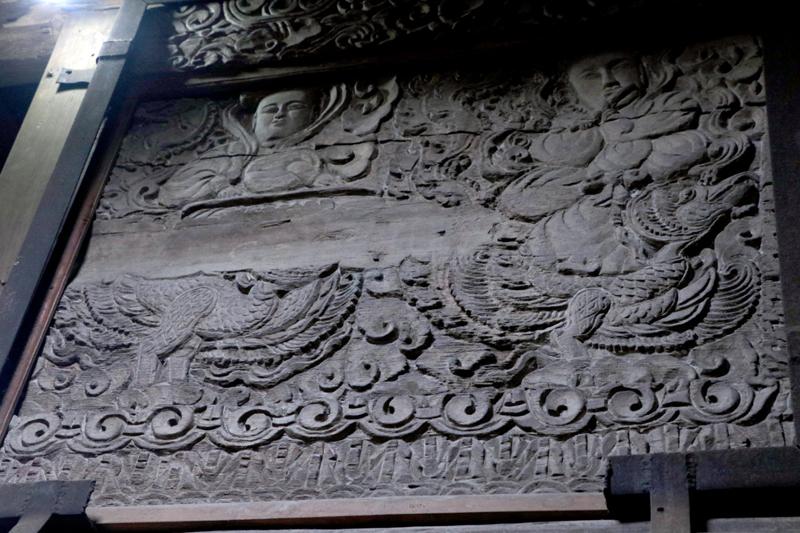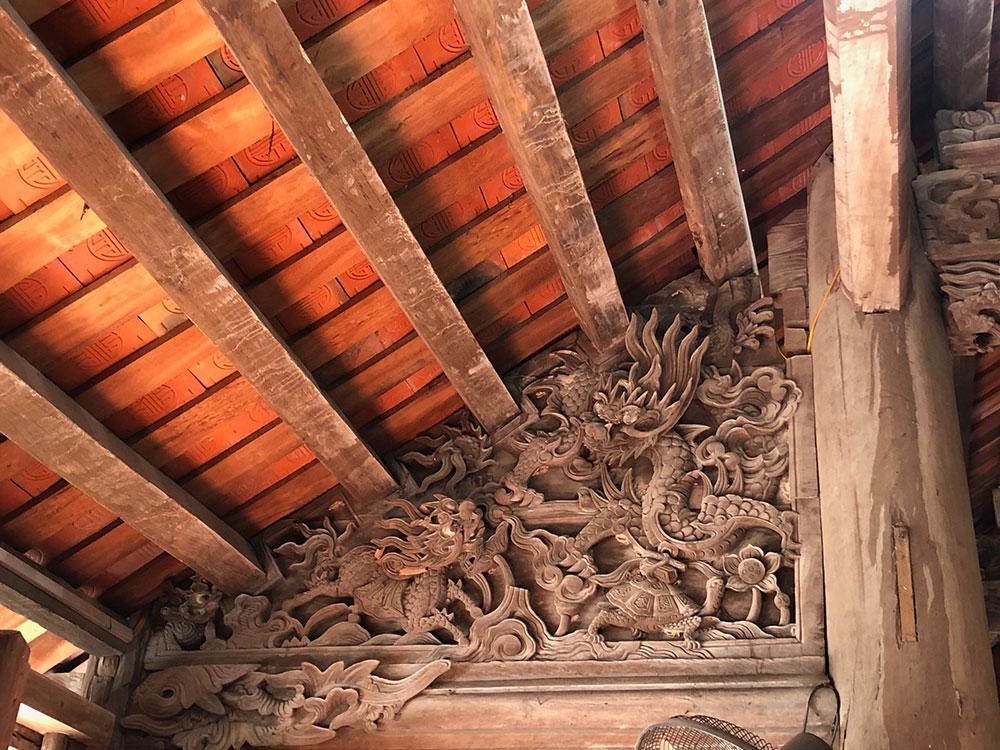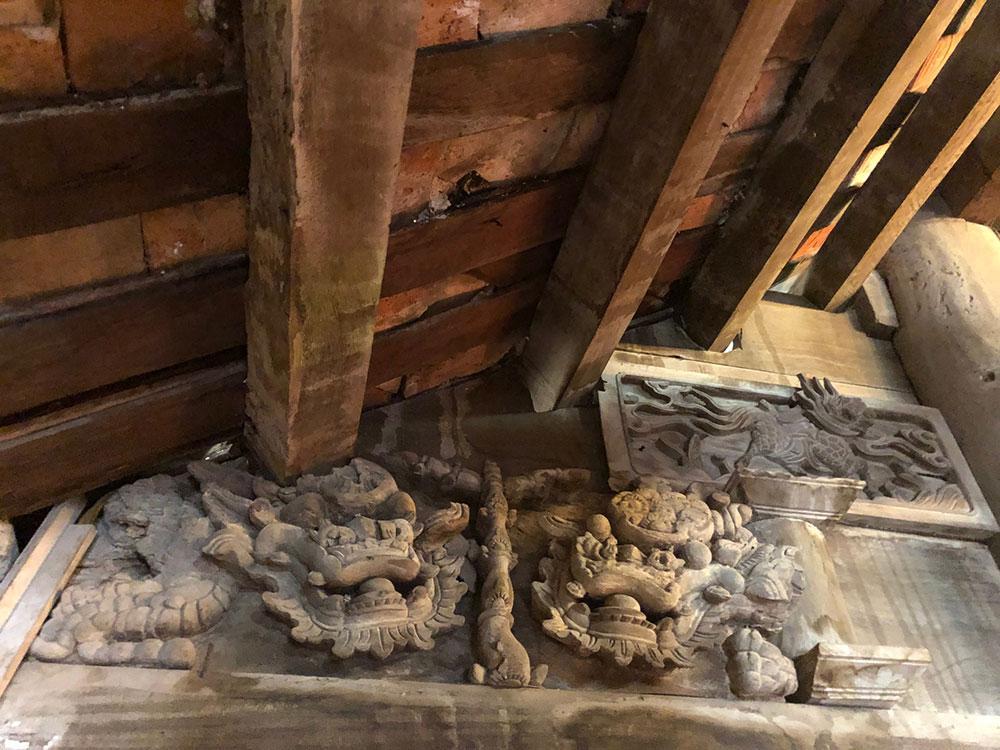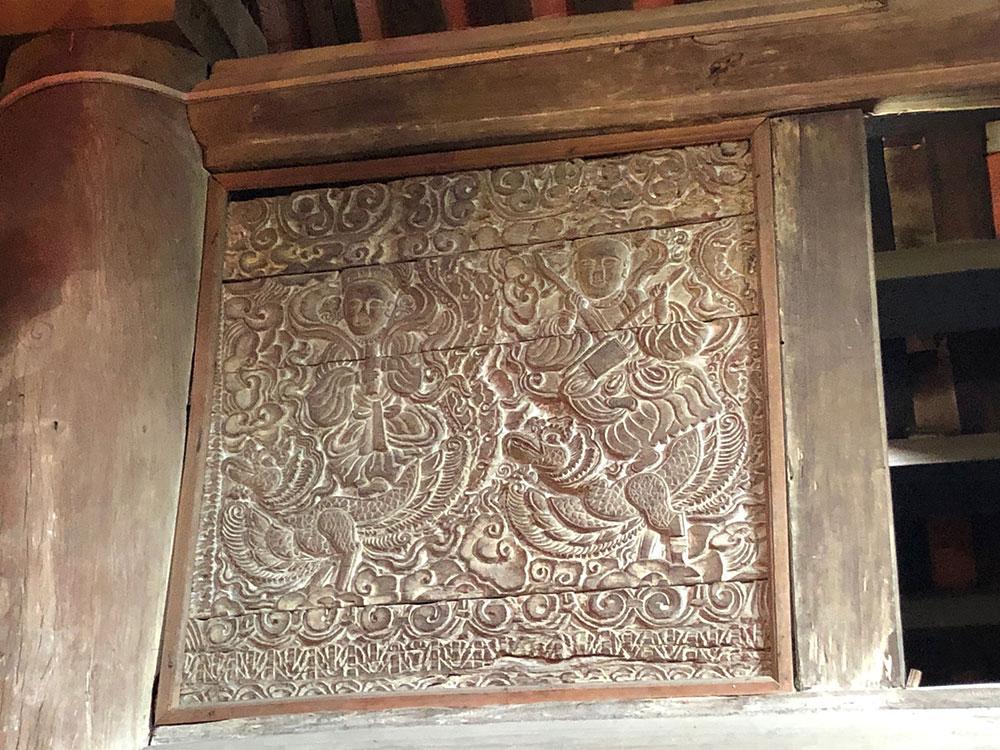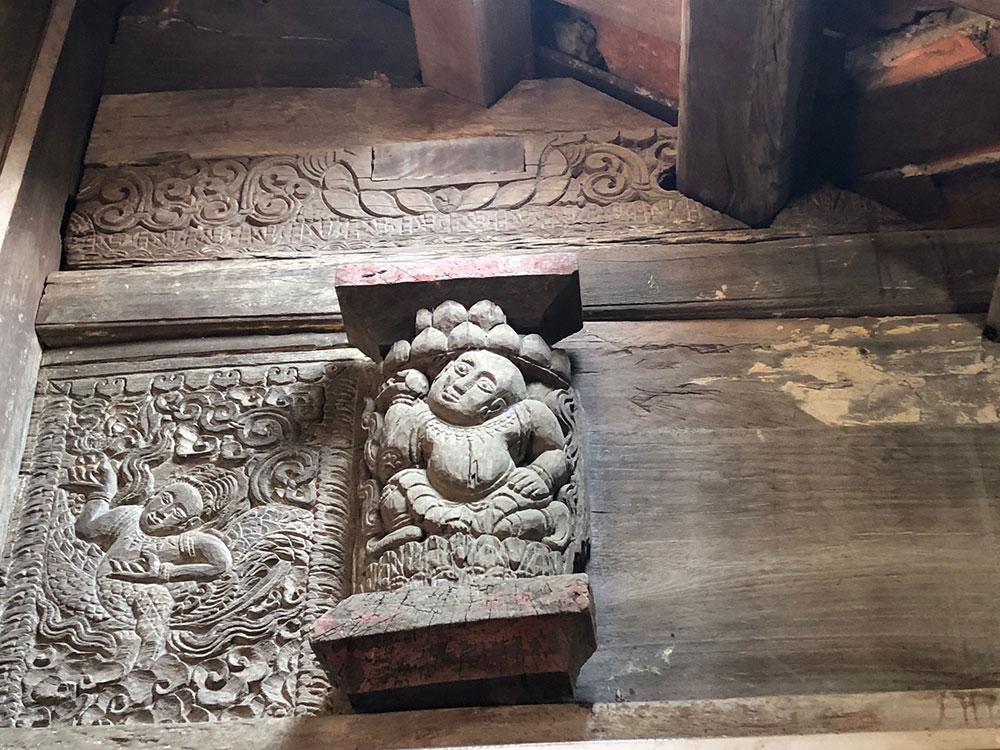Content [Hide]
- Where is Thai temple located?
- History of Thai Lac Pagoda Hung Yen
- Architecture of Thai Lac Pagoda in Hung Yen
- Discover the unique features of Thai Lac Pagoda in Hung Yen
WHERE IS THAI LAC STREAM?
Thai Lac Pagoda (also known as Phap Van Pagoda, Phap Van Tu or Ba Ca Pagoda), belongs to Lac Hong commune, Van Lam district, Hung Yen province. The pagoda is a place to worship Buddha and the god Phap Van – one of the four gods of the Four Dharmas (Phap Van, Phap Vu, Phap Loi, Phap Dien) originating in the Dau region (Bac Ninh province).
HISTORY OF THAI LAC HUNG YEN REPAIR
The pagoda was built in the Ly dynasty, it is a rare place in Vietnam that still retains 1 painting because in the middle of the upper hall is the architecture from the Tran dynasty, in addition to Thai Lac pagoda, only Dau pagoda and Boi Khe pagoda can be found. The wooden carving of the pagoda is carved with the image of the goddess Can Tat Ba, one of the Thien Long Bat Bo of Buddhism.
The jade genealogy of the pagoda is recorded in the 2nd Dai Dinh year in 1162 of the Ly Nhan Tong dynasty. The jade genealogy clearly records the events of the Four Dharmas in Luy Loi that occurred during the Han Linh De Dynasty (168-189 AD).
In 1673 the pagoda was greatly restored.
In 1964, the pagoda was recognized as a national historical relic of the whole country and province.
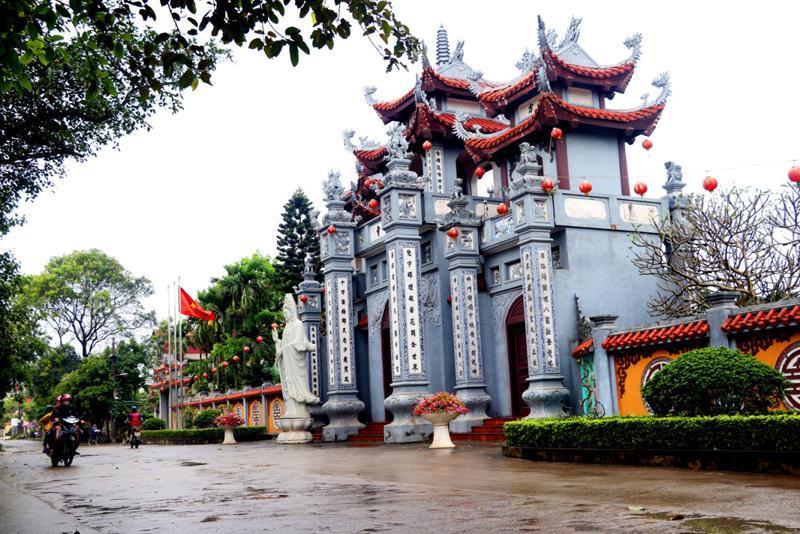
THE ARCHITECTURE OF THAI LAC HUNG YEN STORE
Thai Lac Pagoda was built on a high mound, the façade turns to the Southeast direction, has an architectural plan of the type ” internal and external ” including the work items are arranged in harmony, opposite to form a unified whole. spread along the Northwest – Southeast axis, including: Tam Quan, temple yard, Tam Bao, Ancestral house, Mother house and tower garden.
Tam Quan: built with two floors and eight roofs, the main gate is made higher than the two auxiliary gates. The center line, the roof of the main gate, is decorated in the shape of a nine-story tower. The roof part with the artifactual tips of the long and rolling aniseed, the roof is not wide but is covered with pipe tiles, the roof line is curved in the shape of the boat’s roof. The pillars are square, embossed, and embossed to represent a couple of Chinese couplets describing the beautiful scene and praising the majesty of the Four Dharmas.
Tam Bao : It has an architecture in the style of Gong (工) including: Tien Duong, Thieu Huong and Thuong Dien.
The forecourt : is the largest architectural work. The four sides around the front street are bounded with bricks, the outside is covered with mortar. The roof edge is attached with lemon flowers, in the middle is a rectangle, with three Chinese characters “Phap Van Tu”.

The entrance hall consists of 09 compartments, with the style of the back wall, roofed with traditional Di tiles. Set of four-row column-style structural frame. The system of roof sets is created in the style of ” stacking gong racks “. Because the armpits are “smooth plank” (in the three middle compartments) and ” semi-stacked ” (in the remaining compartments).
All the architectural elements are made of ironwood, the carvings and decorations at the front hall of Thai Lac pagoda mainly carry the style and characteristics of the aesthetic and beauty of the Nguyen Dynasty with many other decorative themes. Each other is shown on the above-mentioned passions because of the armpit of Tien Duong: the theme of the four spirits (long, ly, Quy, phoenix), the theme of the succulent, the theme of plant patterns. Inside the Front Street, there are a number of statues such as Monsignor, Saint Sage, Protector, etc., along with valuable paintings, couplets and worshiping objects.
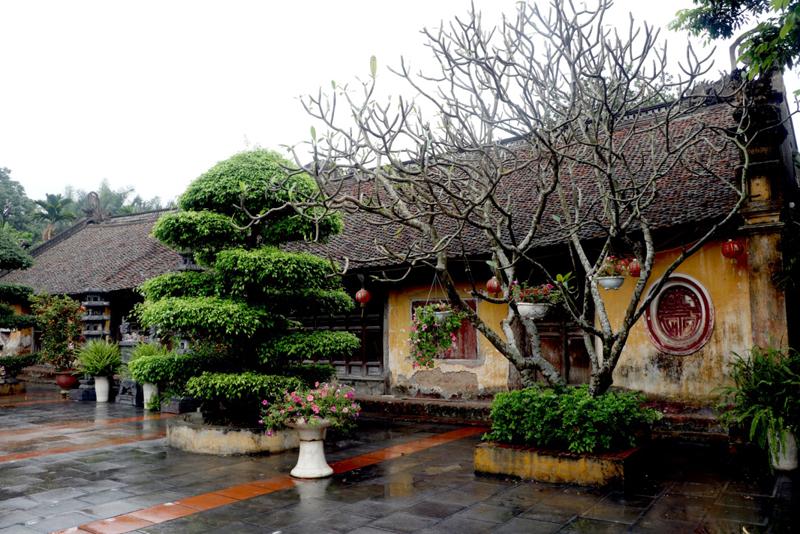
Burning incense : also known as water pipe, connecting Thuong Dien and Tien Duong (2.6m long, 4.2m wide), the ground floor is lower than Thuong Dien, including 2 compartments. The walls are built of brick only, plastered with lime mortar, and the roof is roofed with roof tiles. The roof support system is a set because it is made in a simple truss style, so it is smooth without decorative patterns. The set because adjacent to the upper palace is made in the style of “ con enchantment “, decorated with images of dragons and dragon horses, products of the Nguyen Dynasty’s art at the end of the 19th century.
Upper hall : consists of 01 compartment and 02 wings, connected perpendicularly to Thieu Huong court, 10m long x 8.5m wide. The base is higher than that of the two burning incense buildings and the front hall. The structure has 4 rows of footers, the female column has a diameter of 0.45m x 2.95m high.
The upper hall of Thai Lac pagoda is an ” unprecedented ” treasure of the nation’s traditional wooden architectural sculpture. This place still preserves 20 ancient wooden reliefs with the style of the Tran Dynasty, in which there are unique specimens. In particular, the two sets because the roof of the upper nave is made in the style of ” gong rack ” in a leaf cage to depict the scene of two fairies with the body of a bird offering flowers.
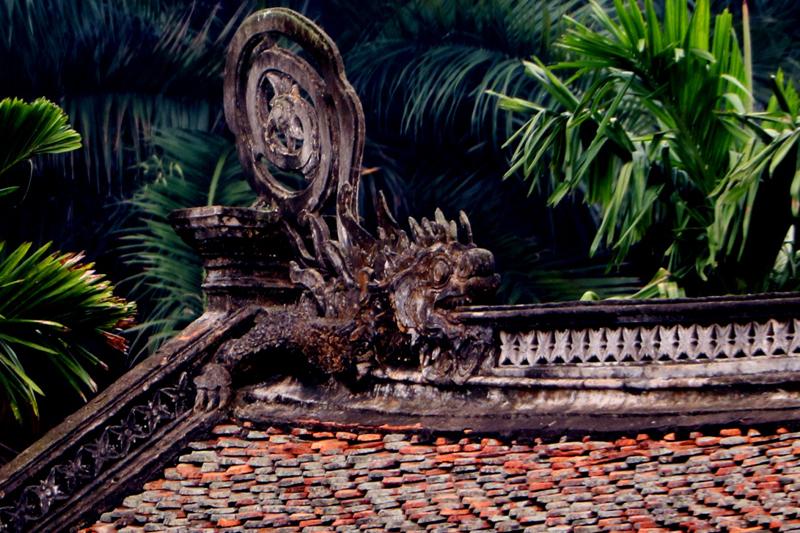
This type in Vietnam is very rare, in addition to Thai Lac pagoda, only found in Dau and Boi Khe pagodas. The topic of decorative sculpture focuses mainly on the plaques and leaves between the two hidden pillars. The plaques here are all carved specifically, meticulously, carefully covering both sides. The large cup is 90cm high x 90cm wide, the small cup is 50cm high x 40cm wide, showing themes: human figures, mascots, flowers and patterns.
The subject of the human figure: is a very rare topic in Vietnamese sculpture under the Tran Dynasty, in which there are carved pieces of typical value:
+ Three-person orchestra : with musicians sitting cross-legged in the clouds, facing slightly to the left, each person performs an instrument: the gentleman in the middle plays the zither and the two women on the two sides. The side carries the Pi Pi and the zither.
These people brought a form close to the way of daily life, dressed in many layers, different from the angel musicians (Gandharva) of the Ly dynasty in terms of movements, costumes and even faces. Although the above image is still associated with Buddhism, it is quite ethereal, so that their music is still rich in angelic colors, in a “holy space”.

+ Fairies offering flowers : the monument still preserves quite a few ancient paintings carved with bird-headed fairies (Kinnara) offering flowers in many different forms. A solitary representation is carved on rectangular slabs. A form showing the couple in the middle, offering flowers together, is embossed in the heart of the leaf.
Another form also shows a couple, but both are facing the same direction, showing the gesture of offering flowers towards the center. All of the Kinnaras are symmetrically carved, with the upper half of the female body, the lower half of the bird with a long tail, extended wings, head tied up in a bun, tight top, head slightly tilted back and double respectfully offering flowers in front of the Buddhas in the ten directions.
Musicians sitting on phoenix birds’ backs playing music: is a topic in Vietnam that can only be found at Thai Lac pagoda. The musicians all sit on the back of the phoenix playing music, carved on two large cones, with two musicians on each side, with the same shape, face, and costumes as the carvings of the three-man orchestra at the temple and the fairies. Women at Dau pagoda (Bac Ninh). They all sat sideways, looking straight ahead. Each person performs a musical instrument: gradually Pi Ba, lute, multi-stringed lute, erhu, pepper, flute, etc.
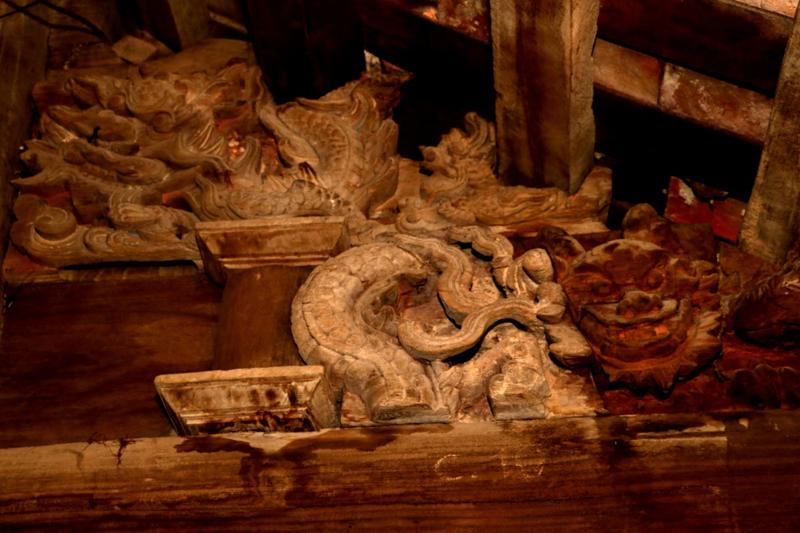
+ Picture Phuong: on the pillars hiding because the roof of the Upper Temple is carved with cute, chubby little boys, in the posture of kneeling on their knees, their heads and hands support the lotus, their necks are tied with ropes, and their shoulders are open. wide, topless, big belly, short skirt, pointed-toe shoes, …. This is one of not many rare and precious specimens bearing the style of the Tran dynasty. The hollow carved pillars are 47cm high and 35cm wide.
Mascot theme:
+ Dragon : The upper temple of the pagoda still preserves a number of unique dragon carvings on the armpit beams. Characteristically, there are children arranged and hidden in the clouds, which is the phenomenon of clouds haunting the dragon’s body first found in Vietnamese visual art. The image of dragons at the Upper Temple is shown in two forms: carved with dragons in the Ly dynasty and a dragon worshiping leaves in the Tran dynasty.
+ Sacred bird: the phoenix is ridden by angel musicians, created with a large, long, twisted beak like a parrot’s beak, two wings spread wide, a long, sine-shaped tail curls upwards, two big strong legs stand on flowers. lotus or tread the clouds.
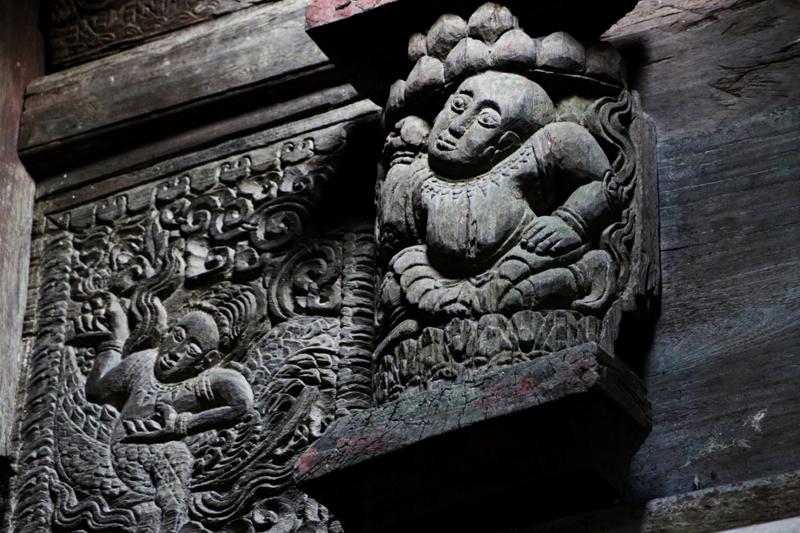
The topic of flowers, leaves, clouds : leaves, lotus flowers, clouds, vines, …
It can be affirmed that the ancient paintings with the style of the Tran Dynasty are only kept in the Upper Palace of Thai Lac Pagoda.
Artists use chisels to bounce on solid wood, the lines make shapes as if drawn with a pen. If in the figure kneeling with a lotus flower, the quality of painting is carefully combined with sculpture, the lines only complement the block array, then the pictures of string flowers and water waves, especially the images of fairies and musicians playing performances
Folk artists have used this language as lines and reliefs, but the quality of painting is stronger than that of sculpture, and the touches are like brushstrokes, sharp and comfortable, contributing to describe a concise and expressive method. An analysis of the social life and Buddhist art of Dai Viet at that time.

In addition, going through these sculptures clearly shows the traditional cultural exchange, the relevance of the Northern traditional culture, the South Asian traditional culture to the traditional aesthetics and beauty of the people. ethnicity.
The Ancestral House (Hau Duong): According to the stone stele of Chinh Hoa 24, erected in the temple garden, specifying the size of the pillars in the middle and the position of the present house, this is the location of the steeple built in 1703.
The ancestral house consists of 7 compartments, wooden frame, because the roof is structured in the style of ” stack of fighting cocks “. This is the place to place the altar to worship Bodhidharma, two neighboring rooms to worship the Second Dharma Master Thich Tam Tich and the successors of the Patriarchs at the temple.
Two rows of corridors : running parallel to the two sides of Upper Palace and Thieu Huong, the last room connects to the ancestral house. Each corridor consists of 07 compartments (18m long x 4m wide x 3.5m high). The system because the roof is made in the style of ” son-in-law fighting “.
Model House: consists of 03 compartments made in the style of a back wall, because the roof is made in the style of ” son-in-law fighting “.
